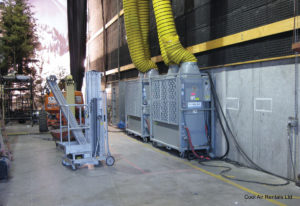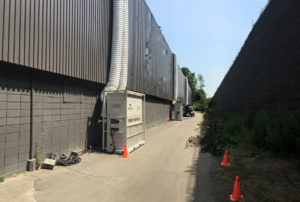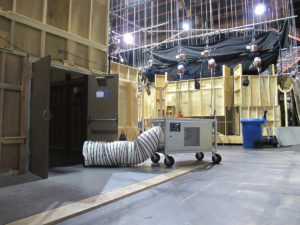Working Together Safely
(updated June 24, 2021)
The COVID-19 pandemic has turned our world on edge. Everyone has been affected and we are continually watching, learning, and behaving in new ways as we navigate this difficult period in history. This document outlines our recommendations and our best interpretation of what will be effective in safely supporting the film industry. This is a live document and we will be adjusting and updating it as new research becomes available.
 Air Changes: Fresh Outdoor Air & Minimum Ventilation Requirements
Air Changes: Fresh Outdoor Air & Minimum Ventilation Requirements
Studio sound stages are large indoor production spaces with vast floor areas and high ceilings, which represents a huge volume of air commonly measured in cubic feet. Current studies suggest that the principal mode of infection of SARS-CoV- 2 (the virus that causes COVID-19) is through exposure to respiratory droplets carrying the infectious virus1. This droplet transmission is most likely to occur via direct contact or through airborne exposure to the aerosolized virus1. Changes to building operations, namely the operation of heating, ventilating, and air-conditioning systems, will help to control and reduce airborne exposure to infectious droplets and aerosolized particles1,2,3,4,5.
Risk Reduction In Sound Stages
 How can we reduce the risk? Given the ASHRAE recommendations for ‘Reducing Airborne Infectious Aerosol Exposure’, Cool Air recommends that production companies implement an air change policy for sound stages.
How can we reduce the risk? Given the ASHRAE recommendations for ‘Reducing Airborne Infectious Aerosol Exposure’, Cool Air recommends that production companies implement an air change policy for sound stages.
WorkSafeBC has minimum ventilation requirements that are based on a relationship between cubic volume and the number of occupants. Some purpose-built sound stages have fresh air capabilities as part of the heating system, which should achieve the minimum requirements set out by WorkSafeBC. However, if your studio has unit heaters hung from the trusses or there are no auxiliary ventilation devices, you will be required to provide something to satisfy the WorkSafe requirements. Check with your studio representative and your Industrial Hygiene Officer to ensure the WorkSafe minimums are being achieved.
The AIHA (American Industrial Hygiene Association) has introduced their ‘Gold Standard’ of ventilation7. Some major Studios have adopted this level of ventilation and are pushing it out to their productions. Consequently, we are seeing requirements in sound stages calling for a minimum of 4 to 6 air changes per hour during occupancy. Simply stated, this means the equipment response must ensure that the air inside the stage is replaced 4 to 6 times every hour with 100% filtered fresh air while people are present.
This will involve a large amount of equipment moving a lot of air in a continuous manner. The air must be dropped and diffused from above, and not directed horizontally, so that the possibility of an infected air stream passing from one person directly into the path of another is avoided2, 3.
The equipment is located outside and provisions will need to be made to deliver the fresh air inside the studio space. This will positively pressurize the sound stage, so there will also need to be provisions to allow for the stale air to escape. We also recommend changing the air inside the sound stage (minimum of one air change) immediately following filming and again prior to filming the next day.
Conditioned Air: Cooling & Heating
Conditioned air is air that has been mechanically cooled or heated. Through the use of our cooling or heating equipment, we can deliver both the desired number of air changes and the conditioned air that is required on set with the same equipment package. Equipment used for spot cooling/heating may need to operate exclusively in interior spaces. In this scenario, the indoor equipment will only augment and not replace the fresh air package that delivers the large volume of air changes required. While this spot-conditioned air will offer you a comfortable temperature inside your space, we have to emphasize the importance of bringing in fresh outdoor air to achieve either the minimum WorkSafeBC volumes, or in striving to achieve the standard set by AIHA.
 Filtration: MERV & HEPA
Filtration: MERV & HEPA
We have upgraded the filters on our cooling units from MERV-8 to MERV-11 rated filters to allow for better particulate capture. We cannot attach HEPA style filters to our cooling or heating units as they are engineered to deliver a certain amount of air at a constant volume. The extra drag imposed by HEPA filters will strain the unit physically and will greatly reduce its effectiveness. We are also offering a filter change out service that is discussed further in our Standard Operating Procedure for Film Industry Installations and Removals.
There are plenty of discussions on the use of MERV-13 and HEPA filters in the fight against COVID-19. MERV-13 filters are currently reserved for medical facilities and are unavailable for commercial use. HEPA filters have the ability to capture the virus (which is approximately 0.125 micron in diameter6) that causes COVID-19. Negative air machines and air scrubbers equipped with HEPA filters are effective in cleaning the air inside small set pieces, production offices and other small spaces. However, when it comes to processing the massive volume of air inside a sound stage, current equipment designed to carry a HEPA filter (~2000 cfm’s) does not have enough capacity to make a measurable and cost-effective difference.
Cleaning Protocols
 Certainly we’ve seen the most change in how we approach surface cleaning since we entered this pandemic. Cleanliness of our equipment has always been front and centre at Cool Air Rentals, and now we are more cognizant of the heightened awareness. We have published our cleaning procedures and they are available in our ‘COVID-19 Protocols for Employees – Film Version’ – available upon request. Simply stated, all of our equipment and accessories undergo a thorough cleaning process, inside and out, with new filters where applicable. All of our equipment is tested and verified before delivery.
Certainly we’ve seen the most change in how we approach surface cleaning since we entered this pandemic. Cleanliness of our equipment has always been front and centre at Cool Air Rentals, and now we are more cognizant of the heightened awareness. We have published our cleaning procedures and they are available in our ‘COVID-19 Protocols for Employees – Film Version’ – available upon request. Simply stated, all of our equipment and accessories undergo a thorough cleaning process, inside and out, with new filters where applicable. All of our equipment is tested and verified before delivery.
References:
- National Centre for Immunization and Respiratory Diseases (NCIRD), Division of Viral Diseases. Science Brief: SARS-CoV-2 and Surface (Fomite) Transmission for Indoor Community Environments. CDC.gov.
https://www.cdc.gov/coronavirus/2019-ncov/more/science-and-research/surface-transmission.html - ASHRAE Epidemic Task Force. Core Recommendations for Reducing Airborne Infectious Aerosol Exposure. Ashrae.org. https://www.ashrae.org/file%20library/technical%20resources/covid-19/core-recommendations-for-reducing-airborne-infectious-aerosol-exposure.pdf
- ASHRAE. Does ASHRAE’s Guidance Agree with Guidance from WHO and CDC? Ashrae.org.
https://www.ashrae.org/File%20Library/Technical%20Resources/COVID-19/Does-ASHRAE-s-guidance-agree-with-guidance-from-WHO-and-CDC.pdf - COVID-19 frequently asked questions: General ventilation and air circulation. Worksafebc.com.
https://www.worksafebc.com/en/resources/about-us/covid-19/general-ventilation-and-air-circulation-covid-19-faq?lang=en - Balgeman S, Meigs B, Mohr S, Neimöller A, Spranzi P. Can HVAC systems help prevent transmission of COVID-19? McKinsey.com. https://www.mckinsey.com/industries/advanced-electronics/our-insights/can-hvac-systems-help-prevent-transmission-of-covid-19
- Heffernan T. Can HEPA air purifiers capture the Coronavirus? Nytimes.com.
https://www.nytimes.com/wirecutter/blog/can-hepa-air-purifiers-capture-coronavirus/ - AIHA (American Industrial Hygiene Association). Reducing the Risk of COVID-19 Using Engineering Controls Guidance. AIHA.org. https://aiha-assets.sfo2.digitaloceanspaces.com/AIHA/resources/Guidance-Documents/Reducing-the-Risk-of-COVID-19-using-Engineering-Controls-Guidance-Document.pdf
